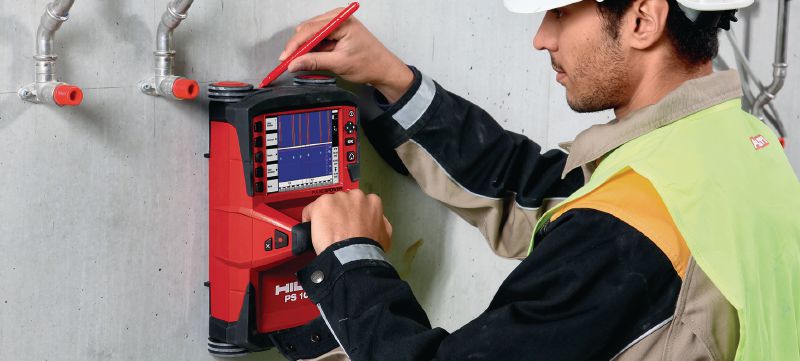Harnessing Technology: RainierGPR Concrete Scanning for Precision Outcomes
Harnessing Technology: RainierGPR Concrete Scanning for Precision Outcomes
Blog Article
Exploring the Depths: A Comprehensive Guide to Concrete Scanning and Its Diverse Applications
In the realm of construction and infrastructure advancement, the careful process of concrete scanning holds an essential function in making certain the architectural honesty and safety and security of tasks. As technology continues to develop, the applications of concrete scanning have broadened much past plain surface-level assessments.
Value of Concrete Scanning
Comprehending the importance of concrete scanning is essential in ensuring the safety and security and stability of structures throughout building and construction and restoration jobs. Concrete scanning utilizes advanced modern technologies such as ground-penetrating radar (GPR) and electromagnetic induction to detect ingrained objects, spaces, or other abnormalities within concrete structures.
Additionally, concrete scanning plays a critical duty in making sure compliance with building regulations and policies that mandate the defense of existing structural parts during building and construction tasks. By properly mapping out the interior structure of concrete, scanning technologies allow construction experts to make enlightened decisions that maintain the structural security and durability of structures and framework projects. Essentially, the importance of concrete scanning hinges on its capacity to safeguard both the structural stability and the employees associated with building ventures.
Technologies Made Use Of in Concrete Scanning
Concrete scanning relies on sophisticated technologies such as ground-penetrating radar (GPR) and electro-magnetic induction to properly spot embedded items and anomalies within concrete structures. Ground-penetrating radar operates by releasing high-frequency electro-magnetic waves right into the concrete.
Electro-magnetic induction, on the various other hand, functions by producing magnetic fields around a concrete structure with a transmitter coil. When metal objects exist within the concrete, they disrupt these magnetic fields, triggering eddy currents to flow via the steel. By determining the changes in the magnetic fields with a receiver coil, the system can determine the area of metal items in the concrete.
These innovative modern technologies play an essential role in non-destructive screening, making certain the safety and integrity of concrete structures in various industries.
Applications in Building And Construction Sector
Within the construction industry, concrete scanning innovation locates diverse applications that improve job efficiency and safety and security. One key application is the discovery of rebar, post-tension cords, and other ingrained objects prior to drilling or reducing into concrete frameworks. By accurately drawing up these aspects, construction groups can prevent costly damages, guarantee structural integrity, and prevent prospective safety dangers. Additionally, concrete scanning is used for situating voids, such as air pockets or areas of wear and tear within concrete, which can endanger the general stamina of a structure. By identifying these gaps early on, building and construction experts can take required steps to resolve them and keep the resilience of the building. Concrete scanning plays an important here function in high quality control by validating the density of concrete covers over support, ensuring compliance with design specs and requirements. On the whole, the applications of concrete scanning in the construction market add significantly to enhancing task operations, decreasing dangers, and supplying premium outcomes.

Safety And Security Benefits of Concrete Scanning
In the realm of building safety and security, the implementation of concrete scanning modern technology presents a vital benefit in preemptively identifying prospective threats and fortifying structural stability. By making use of advanced scanning techniques such as ground-penetrating radar (GPR) and electromagnetic induction, construction groups can accurately find rebar, post-tension cords, avenues, and various other concealed items within concrete frameworks. This positive technique dramatically decreases the threat of unintended strikes throughout boring, reducing, or coring activities, consequently avoiding costly problems, injuries, and task hold-ups.
Additionally, concrete scanning enhances employee safety by offering real-time info regarding the structural condition of concrete aspects. This data makes it possible for construction professionals to evaluate the stability of existing structures, identify degeneration or flaws, and make notified choices relating to fixing and maintenance procedures. By dealing with possible safety worries without delay, concrete click to read scanning adds to developing a safe functioning atmosphere and mitigating the chance of architectural failings or mishaps on building and construction sites. Inevitably, the security benefits of concrete scanning not only secure possessions and lives yet likewise support sector criteria for top quality and reliability.
Future Trends in Concrete Scanning
Arising improvements in scanning technology are poised to transform the field of concrete assessment and analysis. One major fad that is getting grip is the combination of artificial knowledge (AI) and device learning algorithms into concrete scanning tools. By utilizing the power of AI, these systems can assess large amounts of information accumulated throughout scanning procedures to supply more thorough and accurate insights right into the condition of concrete structures. This can help in finding hidden flaws, predicting prospective architectural failings, and even suggesting maintenance approaches.
One more substantial fad is the advancement of even more easy to use and portable scanning devices. Miniaturization of scanning tools enables less complicated accessibility to constrained spaces and remote places, making evaluations extra efficient and comprehensive. Furthermore, improvements in cordless interaction modern technologies make it possible for real-time information transfer and evaluation, helping with quicker decision-making processes.
Additionally, there is an a fantastic read expanding emphasis on sustainability in concrete scanning innovations - RainierGPR Concrete Scanning. Manufacturers are significantly including eco-friendly products and energy-efficient functions right into their tools to decrease environmental effect. These future patterns are readied to boost the performance, accuracy, and sustainability of concrete scanning practices, shaping the sector's future landscape
Verdict
In final thought, concrete scanning plays an important duty in the construction market by making certain the safety and effectiveness of numerous tasks. As technology developments, the future of concrete scanning holds encouraging developments for enhancing building and construction procedures.

Report this page